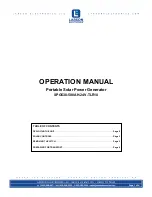
6
REC Installation Manual - REC Alpha Panels - IEC 61215 /61730
Rev 13 - 11.22
PANEL HANDLING
In order to avoid damage, all REC solar panels should be handled with care and protected from damage at all times. All warnings and instructions on
the packaging should be observed. Follow these guidelines when unpacking, transporting, carrying, installing or storing panels:
• Record the serial numbers prior to installation and note the information in the system documentation,
• Carry the panels using both hands and do not use the junction box or cables as a grip,
• Do not allow the panels to sag or bow under their own weight when being carried,
• Do not subject panels to loads or stresses, e.g., leaning on them or through the placing of weight on them,
• Do not stand or walk on the panels,
• Avoid dropping the panels as any damage caused may be unseen,
• Keep all electrical contacts clean and dry,
• Do not apply force to the backsheet,
• Avoid using sharp or pointed objects if panels require marking,
• Never apply paints, adhesives or detergents to the front or rear of the panel,
• Do not use any solar panel that is damaged or has been tampered with,
• Never attempt to disassemble, modify, or adapt the panels or labels in any way as this will void the warranty.
The pallet packaging is not water- or weatherproof. Prior to installation, and to avoid damage or degradation to the packaging or panel components,
pallets and panels must be stored in a controlled environment, ideally internal, where it is protected from the elements, e.g., rain, dust, and direct
sunlight. If overnight storage in an uncontrolled environment is unavoidable, the panels and the pallet packaging must be protected from direct
exposure to the elements and from contact with the ground, including earth, mud etc.
CHOOSING AN INSTALLATION LOCATION
REC solar panels are designed to provide decades of durable and stable output in installations up to 2000 m above sea level. Ambient operating
temperatures must be between -40° and +85°C.
The panels are not suitable for installation in potentially hazardous locations nor should they be installed in the following locations:
• Near sources of flammable gas or vapor e.g., gas containers or spray paint facilities,
• Near open flames,
• Where the panels are exposed to direct contact with salt water/spray,
• Under water or in water features,
• Where exposed to sulfur e.g., near sulfur springs or volcanoes,
• Where exposed to artificially concentrated sunlight,
• Where the panels may be exposed to harmful chemicals.
NOTE
Use clean and protective gloves when handling the panel as this will avoid the transfer of any fingerprints or soiling to the highly-sensitive and
anti-reflective glass surface, ensuring improved light transmission and avoiding any contamination.
i
NOTE
For information regarding installations on water platforms, e.g., floating pontoons, see Annex 1 at the rear of this manual.
i







































